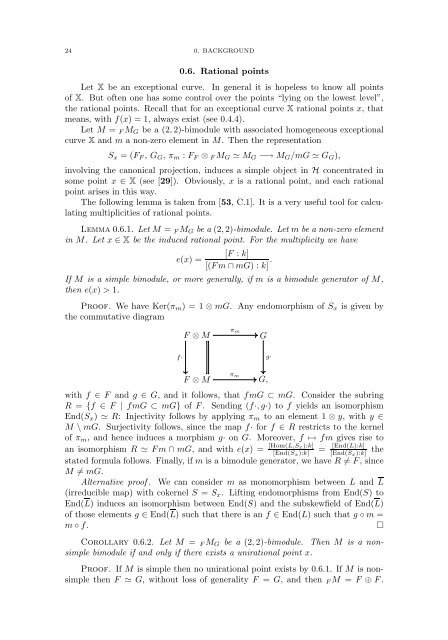MEMOIRS
MEMOIRS
MEMOIRS
- No tags were found...
You also want an ePaper? Increase the reach of your titles
YUMPU automatically turns print PDFs into web optimized ePapers that Google loves.
24 0. BACKGROUND0.6. Rational pointsLet X be an exceptional curve. In general it is hopeless to know all pointsof X. But often one has some control over the points “lying on the lowest level”,the rational points. Recall that for an exceptional curve X rational points x, thatmeans, with f(x) = 1, always exist (see 0.4.4).Let M = F M G be a (2, 2)-bimodule with associated homogeneous exceptionalcurve X and m a non-zero element in M. Then the representationS x =(F F ,G G ,π m : F F ⊗ F M G ≃ M G −→ M G /mG ≃ G G ),involving the canonical projection, induces a simple object in H concentrated insome point x ∈ X (see [29]). Obviously, x is a rational point, and each rationalpoint arises in this way.The following lemma is taken from [53, C.1]. It is a very useful tool for calculatingmultiplicities of rational points.Lemma 0.6.1. Let M = F M G be a (2, 2)-bimodule. Let m be a non-zero elementin M. Letx ∈ X be the induced rational point. For the multiplicity we have[F : k]e(x) =[(Fm∩ mG) :k] .If M is a simple bimodule, or more generally, if m is a bimodule generator of M,then e(x) > 1.Proof. We have Ker(π m )=1⊗ mG. Any endomorphism of S x is given bythe commutative diagramF ⊗ Mπ mGf·g·π mF ⊗ MG,with f ∈ F and g ∈ G, and it follows, that fmG ⊂ mG. Consider the subringR = {f ∈ F | fmG ⊂ mG} of F . Sending (f·,g·) tof yields an isomorphismEnd(S x ) ≃ R: Injectivity follows by applying π m to an element 1 ⊗ y, withy ∈M \ mG. Surjectivity follows, since the map f· for f ∈ R restricts to the kernelof π m , and hence induces a morphism g· on G. Moreover, f ↦→ fm gives rise toan isomorphism R ≃ Fm ∩ mG, andwithe(x) = [Hom(L,S x):k][End(S x ):k]= [End(L):k][End(S x ):k]thestated formula follows. Finally, if m is a bimodule generator, we have R ≠ F ,sinceM ≠ mG.Alternative proof . We can consider m as monomorphism between L and L(irreducible map) with cokernel S = S x . Lifting endomorphisms from End(S) toEnd(L) induces an isomorphism between End(S) and the subskewfield of End(L)of those elements g ∈ End(L) such that there is an f ∈ End(L) such that g ◦ m =m ◦ f.□Corollary 0.6.2. Let M = F M G be a (2, 2)-bimodule. Then M is a nonsimplebimodule if and only if there exists a unirational point x.Proof. If M is simple then no unirational point exists by 0.6.1. If M is nonsimplethen F ≃ G, without loss of generality F = G, andthen F M = F ⊕ F .
















